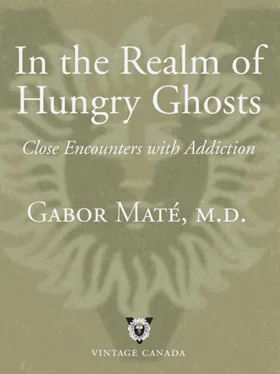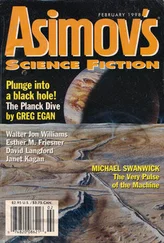In general, the higher in the brain we ascend physically, the more recent are the brain centres in evolutionary development and the more complex their functions. In the brain stem, automatic functions such as breathing and body temperature are regulated; the emotional circuits are higher up; and at the very top surface of the brain is the cortex, or grey matter. None of these areas works on its own; all are in constant communication with other circuits near and far, and all are influenced by chemical messengers from elsewhere in the body and brain. As a human being matures, higher brain systems come to exert some control over the lower ones.
“Cortex” means bark and the multilayered cerebral cortex envelops the rest of the brain like the bark of a tree. About the size and thickness of a table napkin, it contains the cell bodies of neurons organized into many essential centres, each with highly specialized functions. The visual cortex, for example, is in the occipital lobe at the back of the brain. If it sustains damage, as in the case of a stroke, vision is lost. The most recently evolved part of the cortex, distinguishing us from other animals, is the prefrontal cortex, the grey matter area in the front of the brain.
It’s a simplification, but an accurate one, to say that the frontal cortex—and particularly its prefrontal portions—acts as the chief executive officer of the brain. It is here that alternatives are weighed and choices considered. It is also here that emotionally driven impulses to act are evaluated and either given permission to go ahead or—if necessary—inhibited. One of the most important duties of the cortex is “to inhibit inappropriate response rather than to produce the appropriate one,” suggests neuropsychologist Joseph Ledoux. 2The prefrontal cortex (PFC), writes psychiatrist Jeffrey Schwartz, “plays a central role in the seemingly free selection of behaviours” by inhibiting many of the alternative responses that arise in a situation, allowing only one to proceed. “It makes sense, then, that when this region is damaged patients become unable to stifle inappropriate responses to their environment.” 3In other words, people with impaired PFC function will have poor impulse control and will behave in ways that to others seem uncalled for, childish or bizarre.
It is also in the frontal cortex that social behaviours are learned. When the executive parts of the cortex have been destroyed in rats, they are still able to function—but only as immature youngsters who haven’t acquired any social skills. They are impulsive, aggressive and sexually inappropriate. They behave very much like rats reared in isolation with no access to social play and other interactions. 4Monkeys injured in the area of the right prefrontal cortex lose interactive skills such as the reading of emotional cues and the mutual grooming necessary for normal social contact. They soon come to be ostracized by their fellows. Human beings with prefrontal injuries also lose many of their social capacities. Here in the prefrontal cortex important nerve systems are implicated in addiction.
The executive functions of the prefrontal cortex are not restricted to any one area, and its proper workings depend on healthy connections and input from the emotional, or limbic, centres in lower parts of the brain. Conversely, dysfunction in the cortex helps to facilitate addictive behaviour. We’ll now look at one particular prefrontal segment to understand how this happens.

Many studies link addiction to the orbitofrontal cortex (OFC), a cortical segment found near the eye socket, or orbit. 5In drug addicts, whether they are intoxicated or not, it doesn’t function normally. The OFC’s relationship with addiction arises from its special role in human behaviour and from its abundant supply of opioid and dopamine receptors. It is powerfully affected by drugs and powerfully reinforces the drug habit. It also plays an essential supporting role in nondrug addictions. Of course, it doesn’t function (or malfunction) on its own but forms part of an extensive and incredibly complex, multifaceted network—nor is it the only cortical area implicated in addiction.
Through its rich connections with the limbic (emotional) centres, the OFC is the apex of the emotional brain and serves as its mission control room. In normal circumstances in a mature human being, the OFC is among the highest arbiters of our emotional lives. It receives input from all the sensory areas, which allows it to process environmental data such as vision, touch, taste, smell and sound. Why is that important? Because it’s the OFC’s job to evaluate the nature and potential value of stimuli, based on present information—but also in light of previous experience. The neurological traces of early, formative events are embedded in the OFC, which, in turn, is connected with other memory-serving brain structures. So, for example, a smell that in early memory is associated with a pleasurable experience will likely be judged by the OFC in a positive way. Through its access to memory traces, conscious and unconscious, the OFC “decides” the emotional value of stimuli—for example, are we intensely drawn to or repelled by a person or object or activity, or are we neutral? It is constantly surveying the emotional significance of situations, their personal meaning to the individual. Through processes we are not consciously aware of, in microseconds the OFC decides our take on people or on a situation. Since our likes and dislikes, preferences and aversions strongly influence what we focus on, the OFC helps us decide to what or whom we should devote our attention at any given moment. 6
The OFC—particularly on the right side of the brain—has a unique influence on social and emotional behaviours, including attachment (love) relationships. It is deeply concerned with the assessment of interactions between the self and others and plays a ceaseless (but fundamentally life-essential) game of “Who loves, who loves me not.” It even gauges “How much does he/she love me or dislike me?”
While the explicit meaning of words spoken are decoded in specialized portions of the left hemisphere, the right OFC interprets the emotional content of communications—the other person’s body language, eye movements and tone of voice. One cue the OFC watches for is the size of the other’s pupils: in social interactions, especially in eyes set in a smiling face, dilated pupils mean enjoyment and delight. Babies are highly sensitive to such cues—as are aphasiac adults (people who, usually due to a stroke, have lost the ability to understand spoken language). Because they pay heed to physical/emotional rather than verbal messages, young children and aphasiacs have a much better sense of when they are being lied to than most of us.
These split-second analytic functions are unconscious. As in the old Mother Goose rhyme, we may be aware of the results but not of the process:
I do not like thee, Dr. Fell
The reason why I cannot tell.
But this I know, and know full well:
I do not like thee, Dr. Fell
In actual fact, the poor doctor fell victim to the anonymous poet’s orbitofrontal cortex. Or, at the risk of completely alienating readers who aren’t fond of word plays, Dr. Fell had a hard day at the OFC.
The OFC also contributes to decision making and to inhibiting impulses that, if allowed to be acted out, would be harmful—for example, inappropriate anger or violence. Finally, brain researchers have also linked the orbitofrontal cortex to our capacity to balance short-term objectives against longer-term consequences in the process of decision making.
Imaging studies consistently indicate that the OFC works abnormally in drug abusers, showing malfunctioning patterns in blood flow, energy use and activation. 7No wonder, then, that psychological testing shows drug addicts to be prone to “maladaptive decisions when faced with short-term versus long-term outcomes, especially under conditions that involve risk and uncertainty.” 8Due to their poorly regulated brain systems, including the OFC, they seem programmed to accept short-term gain—for example, the drug high—at the risk of long-term pain: disease, personal loss, legal troubles and so on.
Читать дальше













